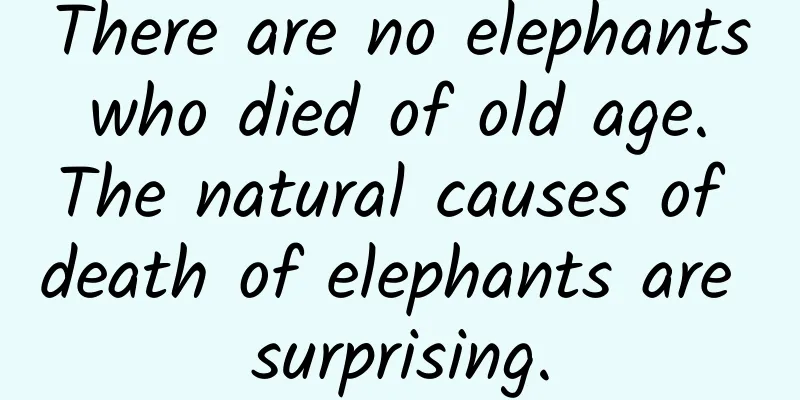There are no elephants who died of old age. The natural causes of death of elephants are surprising.

|
Birth, aging, illness and death are the natural laws that all living things cannot avoid. For wild animals, it is very difficult to survive to old age and death from injury, infection or being eaten is a more common outcome. For some super-large animals, although the possibility of being eaten as adults is relatively low, it seems difficult to die of old age. Elephants are such animals. In the wild, except for poaching, elephants who die naturally mainly die from unexpected reasons: hunger. Humans and elephants are very similar in many ways. For example, they are both social animals and have similar life spans. Theoretically, elephants can live to be 70 years old, but few elephants can live to this age. They do not die from various diseases like humans, but mostly die of starvation. But why do most elephants who die naturally die of starvation? This is due to their special teeth. The teeth mentioned here are not the "ivory" favored by poachers. In fact, the long tusks of elephants are their upper incisors. Although many elephants die because of these two beautiful incisors, the elephants who die naturally are because of their other teeth - molars. African elephant molars (Image source: wikimedia) Among mammals, elephants have very special teeth. Almost all mammals have only three sets of molars, which cannot be renewed after adulthood and grow out in a way similar to the tip of a bamboo shoot. But elephants are different. Elephants have no canines, only incisors and six sets of molars. However, their upper and lower jaws are relatively short and cannot accommodate six sets of molars (a total of 24) at the same time, so these six sets of molars appear one after another. The elephant's molars are like a conveyor belt, moving gradually from the back of the mouth to the front. Baby elephants are born with four baby molars, which are miniature deciduous teeth. These fall out when they are two years old, and are replaced by larger, more permanent molars. The relationship between the six sets of molars of elephants and their life stages. (Image source: doi.org/10.1016/j.mambio.2018.12.004) These molars will fall out as they wear out, and will be replaced by new molars. The new set of molars tends to last longer and be a bit larger than the previous set. When the new teeth grow, the roots of the old teeth are absorbed by the upper and lower jaws. This process is quite uncomfortable, so elephants who are changing their teeth are usually in a bad mood. Sadly, with each new set of molars, the elephant's life countdown advances, and when the sixth set of molars appears, their life enters its final stage. The first to sixth sets of molars of an elephant. (Image source: doi.org/10.1111/j.1469-7998.1988.tb03760.x) This final set of molars appears in their prime, around 30 years old. The sixth set of molars is very different from the other sets. The ends of the first five sets are relatively smooth or flat, but the ends of the sixth set are pointed. The sixth set of molars are used for 20 to 30 years, so if elephants eat too much hard and difficult to chew food, such as bark and thorns, their lifespan will be shortened. EleAid, a charity that helps elephants, says this is why most old elephants die of starvation. Taking into account the special physiology of elephants, some zoos or rescue organizations provide special food for captive elephants. For example, Wildlife SOS, a non-profit organization for wildlife rescue, feeds semi-liquid food to old elephants that have reached their sixth set of molars. Among mammals, apart from elephants, only three species of manatees, one species of kangaroo (Petrogale concinna), and the frost mouse (Heliophobius argenteocinereus) have teeth that are pushed forward from the back. Frost rat (Heliophobius argenteocinereus) (Photo source: wikimedia) That means that out of the 5,500 known mammal species, fewer than 10 species can continually renew their molars. But why do elephants have teeth that are layered like this? Biologists Oscar W. Johnson and Irven O. Buss point out that it is generally believed that the last three sets of molars of elephants correspond to the molars of other mammals in adulthood; however, no one is clear about the origin of the first three sets of molars of elephants. Some researchers believe that the first three sets are equivalent to deciduous molars, which means that elephants are still growing deciduous teeth when they are in their teens. Researchers still haven't figured out why elephants gradually grow teeth as they age. Some researchers speculate that the secret of elephants' teeth may lie in their bones. This is because, although elephants have a lifespan comparable to that of humans, their skeletons mature much later: the backbone of an elephant does not fuse with the epiphysis until around the age of 40, which means that elephants stop growing at around the age of 40, and their last set of molars also appears at around this age. The second reason is that there is a strong positive correlation between elephant tusk stage and bone length, which is also puzzling to researchers. Some speculate that this may be because bone growth drives tooth renewal, or vice versa. Does this mean that as long as elephants take good care of their teeth, they can live to "die of old age"? In any case, the fate of elephants under natural conditions is almost certain. Old elephants tend to get pinker as they get older, as their ears and trunks fade with age. When dying, hungry elephants often seek water, so you can see pink elephants dying near water sources. Tikiri, an elephant performing in Sri Lanka, lived to be 78 years old. This is her dying state. (Photo credit: Save Elephant Foundation) The location of the water source is shared by the same elephant family, so elephants of the same family often die together. This may be the origin of the so-called elephant graveyard. After seeing the natural end of the elephants’ lives, I don’t know whether I should envy them or feel sorry for them. What is admirable is that they died of hunger and no serious illness. What is regrettable is that even if they escaped from poachers, they would inevitably die because of their unique teeth. Human beings: At thirty, one becomes independent. Elephant: Thirty years old. Cover source: wikimedia Reference: https://docs.qq.com/doc/DVHZ4aFBZWWFEcHdi Source: Bringing Science Home |
<<: This amazing scientific phenomenon, even Newton made a mistake about it
>>: What happens if a male wasp without a stinger encounters a predator? | Nature Trumpet
Recommend
WeChat business survey in WeChat Moments: Pyramid scheme-like fraud and huge profits coexist
After the sales of “Friends Circle” became popula...
The most touching marketing cases in 2021
It was screen-sweeping, heart-breaking, and defen...
[Girls' Emotions] Love psychology to save singles, find a good man to love you
[Girls' Emotions] Love Psychology to Save Sin...
Zhang Gang, Operation Director of Longzhu Live: Please get the operation logic that operators must know!
The Internet is a sea of pictures and texts, an...
So cool! China's lunar suit debuts
On the morning of September 28, 2024, China's...
What is the reason for boycotting iPhone? Is it because its ability to make money is too strong and domestic mobile phones cannot compete with it?
Why don't you use domestic mobile phones? Why...
Action Guide for Building a Digital Operation System
The construction of a data-based operation system...
What kind of psychological pressure can college students have? I finally understand after reading this!
In conclusion: In the current popular "crazy...
Xu Huaxin of Discovery Media: Splash screen advertising is just the tip of the iceberg of OTT large-screen marketing
The "2017 China OTT Large Screen Marketing L...
Nearly 180,000 users signed up for a live broadcast event in more than a month. This is what I am most interested in!
Yesterday I saw an activity forwarded by a friend...
Scientists discovered nine ultra-lithium-rich dwarfs at once based on LAMOST's medium-resolution spectrum
Author | LAMOST Operation and Development Center ...
Progress bar example ProgressDialog in Android
Progress bar is used to show the progress of a ta...
Here are four tips to help you avoid wasting money on mobile apps!
You don’t have to build every mobile app yourself...
Community operation methodology: how to gather target users
In early 2015, communities began to become popula...









